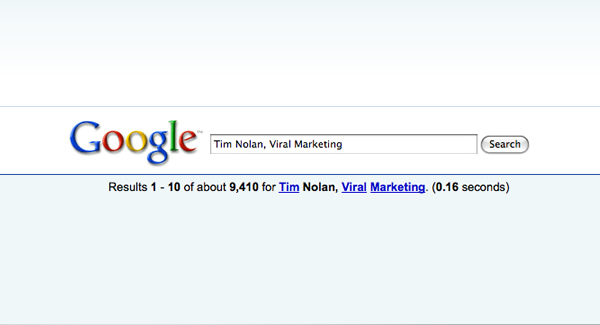Original Content / Viral Marketing Experiment

Viral Marketing by Viral Marketing – or Dont Blame Meme.
I figured that I should address this here. If you Google my name along with the search term “Viral Marketing” today (12/08), you will yield about 10,000 results. When my “campaign” was in full-swing the number of search results reached over 100,000.
It was somewhere between December 2005 and February of 2006, when I first started thinking about this idea.
I was working as the Interactive Creative Director at Night Agency. At that point in time our agency was producing a good deal of work for our clients, that could be defined as either “Branded-Entertainment” or as “Stuff we hoped would go Viral”.. The added value we provided was the service offering we call “Digital- PR/Marketing”. This involved distributing our product across large audiences to create a “buzz” about the brand attached to the media we deployed on their behalf.
This got me thinking… I was set to speak at SXSW again in March of 2006. The panel I was moderating was entitled “The Creative Sublot II – The Viral Edition, and it was centered around the ever-growing concept of “Viral Marketing”.
With all that in mind, I wanted to utilize a Viral Marketing tactic to promote the event. I thought through many different possible mediums, platforms, and distribution channels. I of course thought of the most obvious possibilities like video, they all seemed to be boring and ultimately transparent to me, meaning they sucked.
I knew all the most successful campaigns were the ones that were the hardest to unmask. One of my all time favorite campaigns at the time was, ilovebees.com, a very successful ARG (Alternate Reality Game) developed by 42 Entertainment for Halo 2. What I really appreciated was that i an extremely “lo-fi” looking end-user web-experience was a gateway to a monster, not to mention the clever way the URL was distributed at the end of a traditional television spot. I digress, back to the experiment.
So with a budget of zero dollars, and the need for a campaign that was bullet-proof, meaning I had to credibility among “seasoned” Internet professionals, I had to think along a more introspective path. I knew I had to somehow fool myself since I was the target audience, so I thought… how can I reach, and effect a large audience of web-savvy individuals, and then make them think the way I want them to… all without spending a dollar on marketing, or production? I decided to leverage the world-wide platform we all know and love… The Wikipedia.
Let me begin this paragraph by saying, that to this day, am amazed at how well trusted this online resource is. Reporters use it a a viable reference while researching an article, some even run with it. Social Media Professionals reference me , in their bios, and students use it in their assignments. Now let me say, I know this whole thing “stinks of deception”, but I mean, c’mon, deception lives very near to the heart of marketing and advertising and you all know it. With that said, I “embedded” a few lines of content into the WikiPedia.
Some of the first recorded offline / online viral campaigns were developed by Tim Nolan of Spent2000.com fame circa 1996. By placing abstract pairings of catch-phrases, quotes, song lyrics and image mashups, Mr. Nolan developed a method of creating “buzz” around a URL based installation. Phrases like “This city isn’t safe” placed along side a URL created curiosity enough in people’s minds to remember a URL and visit again once they were online.
I knew there was already a significant amount of meta data out there about me, my personal site, as well as my career imprint on the web having worked in the online industry since 1996. Now armed with a “stealth-media-assassin” deployed via the WikiPedia, my desired Google results began to jump. I would spend days reading blogs posts, white-papers, industry articles, and all anyone ever did was Copy & Paste the above quote into their respective works.
Thousands of people published webpages, PDFs, and various slide presentations on the subject of viral marketing, all of them, including me and my ARG Themed Wiki-Hack nestled inside of them. The ROI was immense considering everything you now know. This experiment also made me thing alot about how much faith we as a people are putting into the Internet and the information found on it in wider terms. The duration of the “reality-hack” lasted about six to nine months, however the results are still highly visible across the Internet today. Needless to say the rogue information has since been removed from the WikiPedia, and the world has returned safely to normal.
Trackbacks